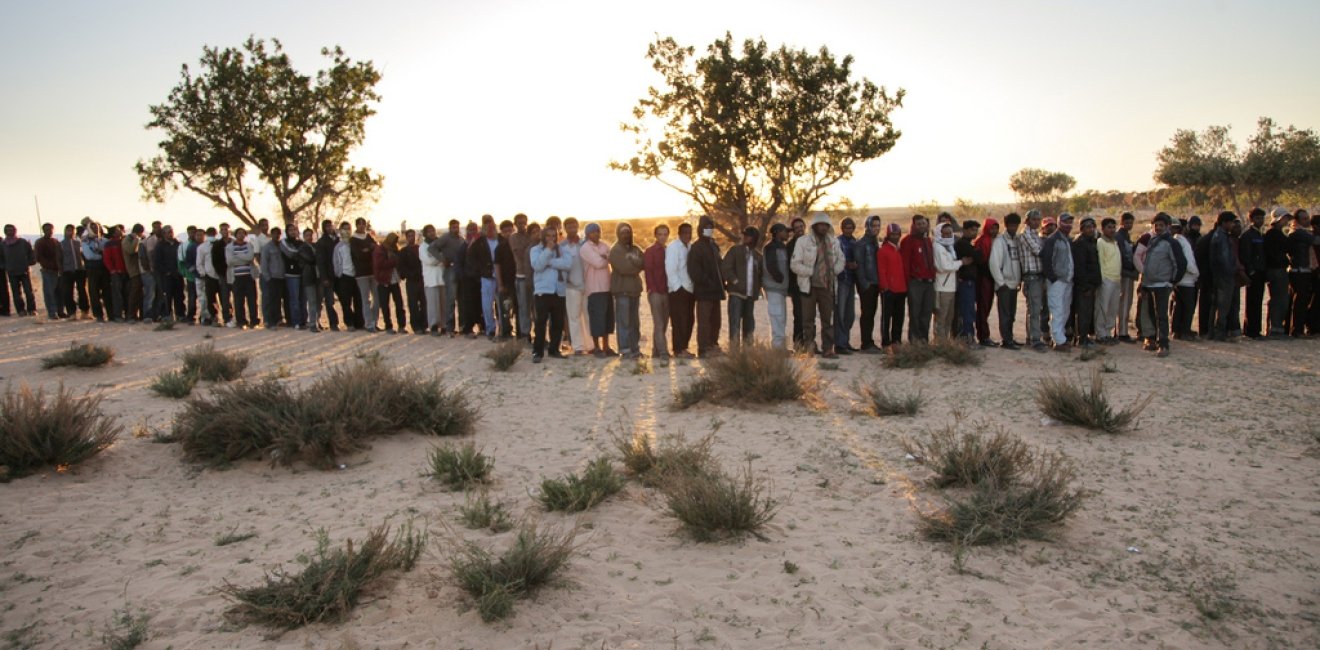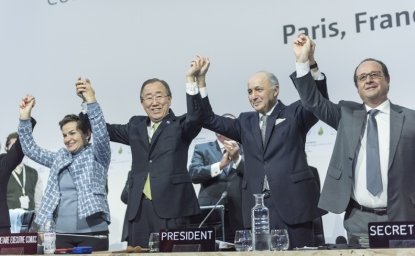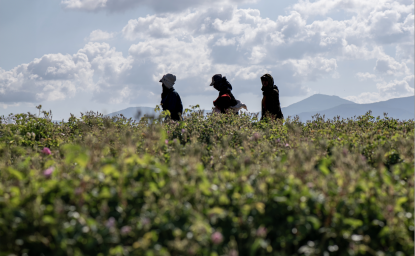One of the hidden costs of climate change is the displacement of millions of people in some of the poorest regions of the globe. The existing international refugee regime is ill-suited to cope with those seeking refuge from environmental disasters. Countries must get serious about developing coordinated plans to address the issue, lest they be caught by surprise when another humanitarian crisis hits.
When world leaders met in Paris to discuss ways to mitigate climate change, human displacement and its consequences for migration and refugee policy was hardly on the agenda although negotiators knew its critical importance. The European Commission, for example, argues that “The greatest single impact of climate change could be on human migration with millions of people displaced by shoreline erosion, coastal flooding, and agricultural disruption—a crisis in the making.” Yet during the climate summit, set against the backdrop of the Paris terror attacks on November 13, 2015, many countries were scrambling to limit immigration and stop the flood of refugees from the Middle East and elsewhere.
Since 2008, an average of 26.4 million people per year have been displaced by natural disasters, according to an estimate by the Internal Displacement Monitoring Center. Displacement will likely increase as repeated drought forces people off their farms; sea-level rise inundates coastal areas and low-lying islands; and tropical storms devastate communities. Most of those displaced will remain in their own country or flee to a neighboring state, but a share of them will attempt to migrate to Europe, North America, Australia, Japan, and other wealthy states.
Industrialized countries are not only ignoring the issue, but actively undermining attempts to craft durable solutions. For instance, in advance of the Paris climate summit, Australia helped to scuttle a plan to create a coordination facility for handling climate refugees, even as its Pacific Island neighbors were raising alarms about the impact of rising oceans.
The Syrian and Iraqi refugee crisis has focused international attention on migration to the Global North. Rather than shape a response guided by compassion and respect for human rights, countries have erected physical and figurative walls to keep migrants out. From the Front National (FN) in France, to nationalist parties in Eastern Europe, to Republican presidential candidates in the United States, groups on the political right have cast migrants as threats to national security. The FN, led by Marine Le Pen, had a breakthrough in French regional elections, coming first in six of the thirteen regions in the first round of voting on December 6, 2015; but in the second round, thanks to cross-over voting by the socialists, the mainstream "republican" right was able to block her advance and in the end the FN did not win control of a single regional council. Nonetheless the FN captured almost 28 percent of the vote in the second round, making it a force to reckon with. Le Pen has stated her strong opposition to international climate talks, as has the leading Republican candidate in the U.S. presidential primaries, Donald Trump, who denounced U.S. participation in the Paris summit as a sham.[4] Both politicians have also expressed their hostility towards migrants and refugees.
Climate change and refugee status
Since at least the 1951 adoption of the Convention Relating to the Status of Refugees, the global migration regime has distinguished between economic migrants, who come to pursue work, and refugees, who flee war and persecution. Environmental migrants do not fit neatly into either category, leading some scholars like Alexander Betts to call for an expansion of the international legal definition of a refugee to take account of the realities of climate change and to include people fleeing natural as well as man-made disasters, trying simply to survive .[5] When a cyclone destroys homes and people look for shelter elsewhere, it is clear that they were displaced by disaster. But when long-term drought and repeated crop failures in a region like the Sahel in Africa deepens poverty among communities already marginalized and harassed by the state because of ethnic or political cleavages, climate, poverty, and persecution all play a role in the decision to leave. Attempts so far, however, to expand the legal definition of refugees to include those fleeing natural disasters or to revise the refugee convention, have gotten nowhere.
A new legal framework is needed to address the different challenges faced by communities severely affected by climate change.
- Low-lying island nations may become wholly uninhabitable if sea-levels continue to rise. People in Micronesia, the Caribbean, the Seychelles, Mauritius, and others, may require outright relocation.
- Larger countries with significant coastal populations, such as India and Bangladesh, may be able to accommodate internal migration from areas affected by sea rise but will need significant assistance in doing so.
- Rapid-onset natural disasters, such as hurricanes and typhoons, will force people to seek temporary shelter elsewhere in the country or across borders.
- Slowly unfolding disasters, including desertification and water shortages, will harm economic development and force people out of climate-sensitive livelihoods.
- Climate change may exacerbate—if not directly cause—violent conflict within and between states by intensifying competition for resources, prompting people to flee their homes.
The last category—those fleeing conflict—can already be accommodated by the existing refugee regime and the UN High Commissioner for Refugees, though additional resources may need to be allocated to humanitarian relief efforts. The first category—entire populations being relocated as island nations are submerged—will require new multilateral agreements for resettlement. Yet the population of these countries is sufficiently small that a global agreement may yet be reached if more attention is focused on the issue.
The other categories speak to the intersection of environmental pressures and development challenges. Improved flood defenses; disaster preparedness and response plans; urban planning to relocate families; more efficient water storage and irrigation schemes; access to improved seeds and fertilizers; and the like can help people adapt to a warming planet where they are rather than moving long distances, leaving their homes and families behind, and starting over. If, however, developed countries do not get serious about mitigating carbon emissions and promoting development strategies that help the poor adapt to climate change, they will find an ever-increasing stream of migrants at their doorstep.
Even if countries agree to robust mitigation and adaptation plans in Paris—a big “if”—it is likely that environmental pressures will continue to influence people’s migration decisions. Many environmental refugees will seek entry into Europe, the United States, Canada, Japan, Australia, and even China—the very countries that have been the biggest contributors to greenhouse gas emissions. Some countries, such as the United States, already afford those fleeing natural disasters temporary protected status (TPS) and a work permit as long as conditions in the sending country prevent safe return.
Yet such measures are haphazard and are not well coordinated across countries. At a minimum, the United Nations can empower the UN Office for the Coordination of Humanitarian Affairs to declare disaster-affected areas to be unsafe for human habitation and urge states not to return displaced people to their country of origin for a temporary period. This would be a logical corollary of the principle of non-refoulement, which forbids rendering a victim of persecution to the persecutor. Although a binding treaty to this effect may be difficult to craft and ratify, once it is in place countries that violate the humanitarian principle of non-return to dangerous conditions can be more readily identified.[8]
The opinions expressed here are solely those of the authors.
James F. Hollifield is professor of political science, Ora Nixon Arnold Chair in International Political Economy, and director of the John Goodwin Tower Center for Political Studies at Southern Methodist University. Hollifield is a public policy fellow at the Wilson Center for 2015-16. Idean Salehyan is associate professor of political science at the University of Texas at Dallas, co-director of the Social Conflict in Africa Database project, and a research associate of the Tower Center.
[1] European Commission, “COP21 UN Climate Change Conference, Paris,” http://ec.europa.eu/priorities/energy-union/emissions-reduction/cop21/index_en.htm (accessed 8 December, 2015).
[2] http://www.internal-displacement.org/publications/2015/global-estimates-2015-people-displaced-by-disasters/ (accessed 8 December 2015).
[3] “UN Drops Plan to Help Move Climate-Change Affected People,” The Guardian, October 6 2015, http://www.theguardian.com/environment/2015/oct/07/un-drops-plan-to-create-group-to-relocate-climate-change-affected-people (accessed online 8 December 2015).
[4] “French National Front launches nationalist environmental movement,” The Guardian, December 18, 2014. “Trump: China ‘laughing’ at us over climate talks,’ Politico, December 2, 2015.
[5] Alexander Betts, Survival Migration: Failed Governance and the Crisis of Displacement (Ithaca: Cornell University Press, 2013). See also Susan F. Martin, International Migration: Evolving Trends from the Early Twentieth Century to the Present (New York: Cambridge University Press,2014), 214-34.
[6] Benjamin Glahn,.. “Climate Refugees? Addressing the International Legal Gaps,” International Bar Association, June 2009, http://www.ibanet.org/Article/Detail.aspx?ArticleUid=CFF74F3D-A4D4-49A4-A40F-4C85BFDE6BBB (accessed 8 December 2015).
[7] Madeline Messick and Claire Bergeron, “Temporary Protected Status in the United States: A Grant of Humanitarian Relief that is Less than Permanent,” Migration Information Source, 2014, http://www.migrationpolicy.org/article/temporary-protected-status-united-states-grant-humanitarian-relief-less-permanent (accessed 8 December 2015).
[8] Again see Martin, International Migration, 222-28.
Image Source: Refugees from Libya Queue for Food at Tunisia Transit Camp (UN Photo) (CC BY-NC-ND 2.0)







